Magnetic Pump

What is a Magnetic Drive Pump (Acid-Resistant Pump)?
A magnetic drive pump, also known as a polymer pump, acid-resistant pump, or magnetic pump, belongs to the centrifugal pump family. It is used to transfer various chemical, acidic, and alkaline fluids, solvents, etc., at different pressures and capacities from milliliters per hour to cubic meters per minute in various industries. In this industrial equipment, instead of mechanical shaft force, a magnetic force is used as the driving force for the impeller and consequently the movement of the fluid.
The driving magnet and the internal magnet in this pump create a magnetic force between the motor shaft and the impeller, creating a seal-less chamber and preventing fluid leakage from the pump. Due to the strict concerns and requirements of international environmental organizations, magnetic pumps prevent the release of hazardous fluids and comply with the necessary standards. Due to their simplicity, these pumps save time and cost during maintenance by replacing seals and preventing dangerous leaks.
Acid-resistant pumps are usually made of materials with high strength, temperature, and pressure resistance. With only two moving parts that are more likely to wear out than other parts, they have a low probability of failure and are a solution for reliability and minimal pollution.
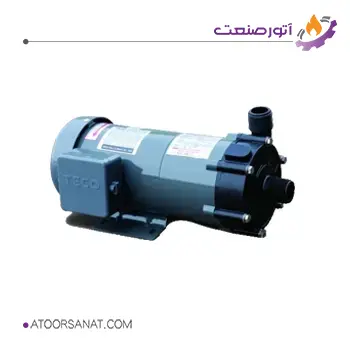
Features:
- Country of origin: Taiwan
- Maximum pressure: 2.5 bar
- Body material: PP – PVDF
- Applications: For transferring various acids and bases, chemicals, poisons, hazardous fluids, aromatics, solvents, etc.
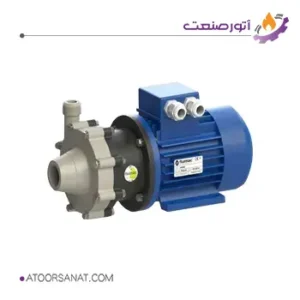
Features:
- Country of origin: Italy
- Maximum head: 7.5 – 8.5 – 14 – 20 – 24 meters
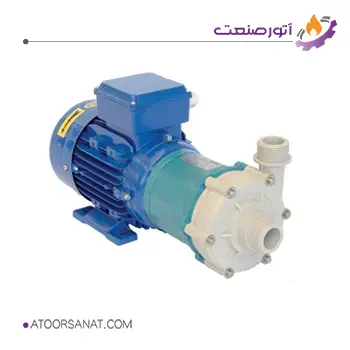
Features:
- Country of origin: Italy
- Maximum pressure: 2.5 bar
- Body material: PVDF, PP
- Applications: Transferring various acids and bases, chemical fluids, valuable fluids, toxic fluids, etc.
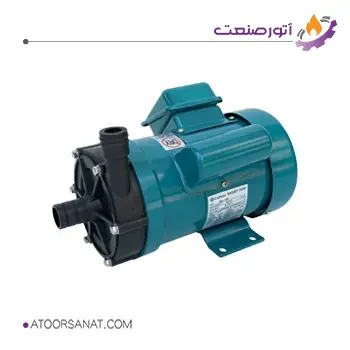
Features:
- Country of origin: China
- Maximum pressure: 0.85 to 2.5 bar
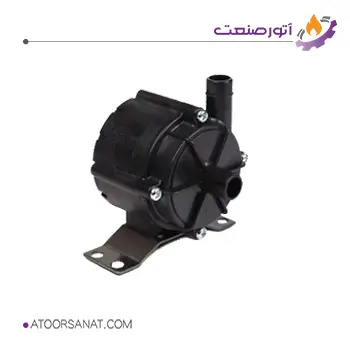
Features:
- Country of origin: Korea
- Maximum head: 3 – 10 meters
- Applications: For transferring acids, bases, poisons, hazardous fluids, aromatics, and solvents, etc.
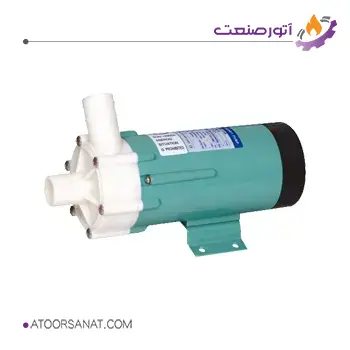
Features:
- Country of origin: China
- Head range: 1 to 14 meters
- Applications: For transferring acids, bases, hazardous fluids, aromatics, etc.
How a Magnetic Pump Works
Unlike conventional centrifugal pumps, there is no direct connection between the electric motor and the impeller in a magnetic pump. These pumps have two concentric chambers, an outer and an inner one, with magnets, one of which is connected to the motor shaft at the rear and the other to the internal shaft on the impeller at the front. These two assemblies are separated by a static seal, shell, or diaphragm, which prevents the fluid from penetrating the outer part.
When the pump motor is started and its shaft rotates, the outer magnet or driving magnet starts to rotate, creating a rotating magnetic field. This causes the inner chamber to move and consequently, the impeller to rotate due to magnetic attraction and repulsion, or in other words, magnetic coupling. With the movement of the acid-resistant pump impeller, centrifugal force is created, and this force causes the fluid to enter the center of the impeller through the inlet. The movement of the fluid during rotation, caused by the impeller blades, creates a discharge pressure, and the blades direct the fluid towards the outlet port.
Components of a Magnetic Pump:
Like any other pump, a magnetic pump requires an energy source, usually an electric motor, and due to the power limitations caused by magnetic coupling in this industrial equipment, it can accept up to 400 kilowatts of power. The body of the acid-resistant pump contains the pump components and is usually made of metal (cast iron, steel, bronze, titanium) or non-metal (glass, ceramic, etc.). The outlet of these pumps is also in the form of a flange or thread, which is determined based on the type of application.
Magnetic coupling and torque transfer from the motor to the impeller is the task of the outer and inner magnets. It should be noted that the inner chamber magnet or moving magnet, which is exposed to the pumped fluid, is coated with a protective resin or placed in a corrosion-resistant housing such as polypropylene, PVDF (polyvinylidene fluoride), ETFE or stainless steel.
The impeller is an energy converter and has blades that are responsible for transferring centrifugal force to the fluid, causing the fluid to move from outside to inside the pump and increase its pressure and exit the pump. Care should be taken in selecting the impeller material so that it is resistant to corrosion, abrasion, and temperature.

